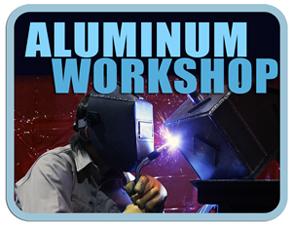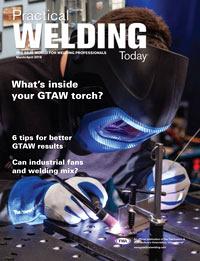President
- FMA
- The Fabricator
- FABTECH
- Canadian Metalworking
Categories
- Additive Manufacturing
- Aluminum Welding
- Arc Welding
- Assembly and Joining
- Automation and Robotics
- Bending and Forming
- Consumables
- Cutting and Weld Prep
- Electric Vehicles
- En Español
- Finishing
- Hydroforming
- Laser Cutting
- Laser Welding
- Machining
- Manufacturing Software
- Materials Handling
- Metals/Materials
- Oxyfuel Cutting
- Plasma Cutting
- Power Tools
- Punching and Other Holemaking
- Roll Forming
- Safety
- Sawing
- Shearing
- Shop Management
- Testing and Measuring
- Tube and Pipe Fabrication
- Tube and Pipe Production
- Waterjet Cutting
Industry Directory
Webcasts
Podcasts
FAB 40
Advertise
Subscribe
Account Login
Search
Aluminum Workshop: What not to do when excessive contact tip burnback occurs
Part II
- By Frank Armao
- March 28, 2016
- Article
- Aluminum Welding
Last time we discussed how using oversized contact tips can cause burnbacks. This time I will discuss other conditions that can cause burnbacks in aluminum gas metal arc welding (GMAW).
A fundamental principle of GMAW is that the wire feeder must operate at exactly the same rate that the arc energy being supplied by the power source is burning it off. If you are not feeding enough wire for the arc energy that is being supplied, you will get a burnback. While it’s theoretically possible for the power supply to be the cause of burnbacks, a more common cause are the small irregularities that occur in wire feeding. Let’s be more specific:
- Set the brake on the wire spool just tight enough to prevent freewheeling. If it is set too tight, it can put excessive tension on the wire and cause feeding irregularities.
- Make sure you have drive rolls that work specifically for aluminum wire. Such rolls have a U-shaped groove and are made for a specific wire diameter. Drive rolls for steel have a V-shaped groove or a serrated groove.
- Set the drive roll tension according to the manufacturer’s recommendation. Too little tension will cause wire slip in the rolls, resulting in burnbacks. Too much tension will deform the relatively soft aluminum wire, making downstream feeding more difficult.
- Use the correct gun liner to feed aluminum. Liners for steel wire are usually a helically coiled steel tube. If you use one of these to feed aluminum, the steel will shave little bits of aluminum from the liner, which will, in a short time, begin to clog the liner. Liners for aluminum are made from a plastic tube and often have a 2-to-3 in.-long helically wound brass tip. The purpose of the tip is to prevent the plastic from melting from the heat of the contact tip.
- Aluminum wire is obviously much softer than steel. Make sure the GMAW gun is set up correctly so that the wire doesn’t scrape against any steel parts of the feeder. A wire the scrapes against components will leave aluminum shavings in the liner, which will accumulate and plug it up.
- Use plastic, not steel, inlet and outlet guide bushings/plates in the feeder. Steel bushing usually are used to feed steel wire.
If you perform this relatively simple tune-up on your wire feeder and gun, I will bet that you’ll experience fewer burnbacks.
About the Author

Frank Armao
Aluminum Consulting Inc.
440-479-0239
About the Publication
Related Companies
subscribe now

The Welder, formerly known as Practical Welding Today, is a showcase of the real people who make the products we use and work with every day. This magazine has served the welding community in North America well for more than 20 years.
start your free subscription- Stay connected from anywhere

Easily access valuable industry resources now with full access to the digital edition of The Fabricator.

Easily access valuable industry resources now with full access to the digital edition of The Welder.

Easily access valuable industry resources now with full access to the digital edition of The Tube and Pipe Journal.
- Podcasting
- Podcast:
- The Fabricator Podcast
- Published:
- 04/16/2024
- Running Time:
- 63:29
In this episode of The Fabricator Podcast, Caleb Chamberlain, co-founder and CEO of OSH Cut, discusses his company’s...
- Trending Articles
Sheffield Forgemasters makes global leap in welding technology

Welding student from Utah to represent the U.S. at WorldSkills 2024

Lincoln Electric announces executive appointments

Engine-driven welding machines include integrated air compressors

ESAB unveils Texas facility renovation

- Industry Events
16th Annual Safety Conference
- April 30 - May 1, 2024
- Elgin,
Pipe and Tube Conference
- May 21 - 22, 2024
- Omaha, NE
World-Class Roll Forming Workshop
- June 5 - 6, 2024
- Louisville, KY
Advanced Laser Application Workshop
- June 25 - 27, 2024
- Novi, MI



























